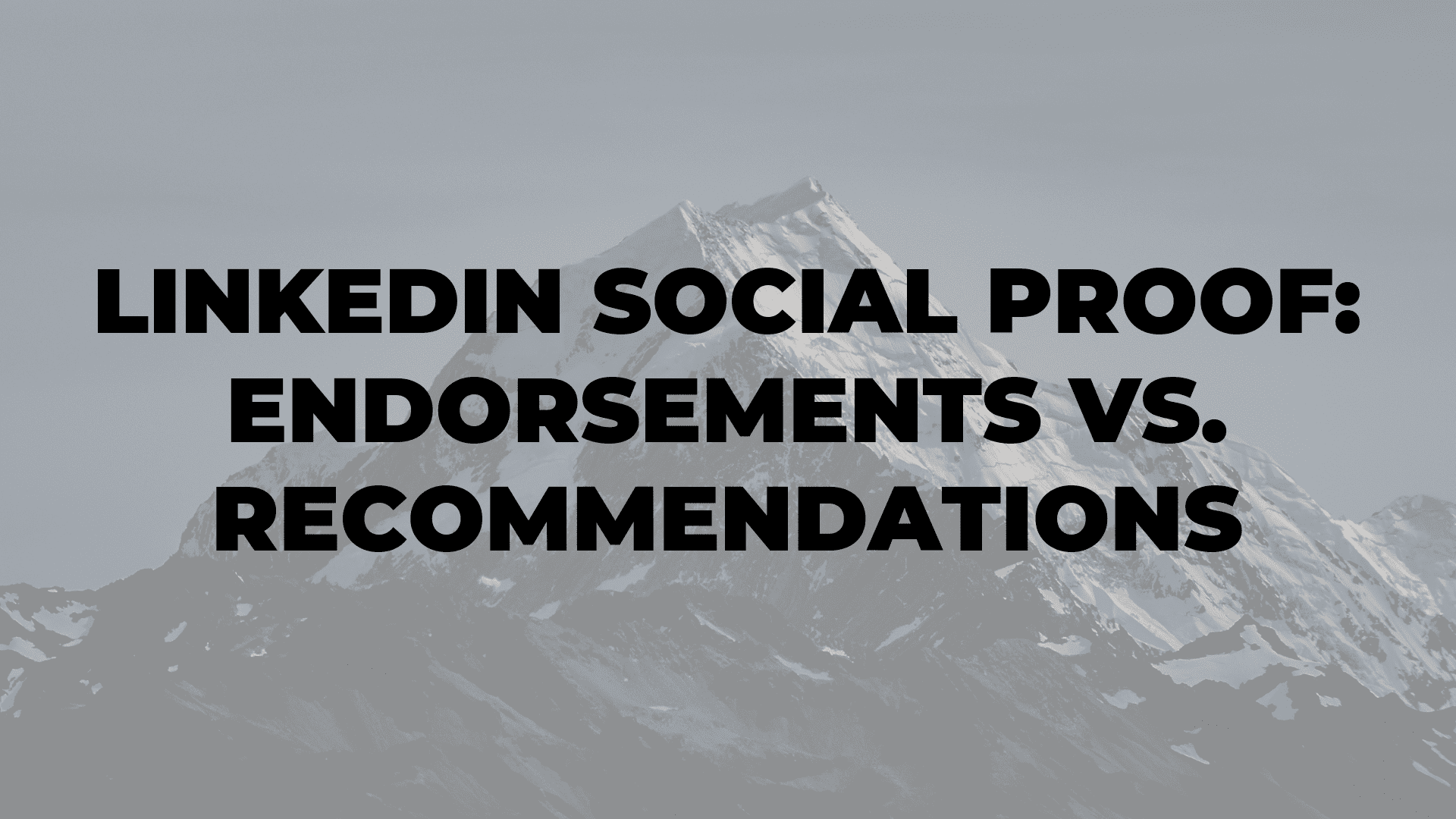LinkedIn Social Proof: Endorsements vs. Recommendations
Social proof refers to the establishment of third-party credibility, and it can be extremely important to your business success. Since LinkedIn is the number one social platform for generating B2B




Social proof refers to the establishment of third-party credibility, and it can be extremely important to your business success. Since LinkedIn is the number one social platform for generating B2B leads, it's critical that you garner substantial social proof on LinkedIn. There are two very powerful ways which you can feature your third-party credibility on LinkedIn, and that is by using recommendations and endorsements.Each of these provides its own distinctive benefits, and each one has its own set of considerations which you need to be aware of before using them. This discussion will center on the differences between LinkedIn endorsements and recommendations and will discuss some options you have for acquiring more of each.
LinkedIn endorsements
When talking about a LinkedIn endorsement, you're really dealing with a single-click process which allows members on the platform to publicly endorse specific skills that you have. Because this single-click process is so easy, many people tend to issue them without giving much thought to the process. It's very common for LinkedIn members to issue endorsements for others without actually knowing anything at all about the person, or their supposed skills.If you haven't provided any more social proof than endorsements from other LinkedIn members, it's easy to see why professionals might view your list of endorsements with skepticism. However, if you can back up your endorsements with other social proofs, you will gain additional credibility in the eyes of reviewers. It's also true that people will be much more impressed by seeing a LinkedIn member who has 100 or more endorsements, as opposed to someone who might have five or six.
Managing endorsements

There is a specific procedure you have to follow in order to endorse someone on LinkedIn. First, go to their profile and scroll down until you come to the section entitled Skills and Endorsements. Find the specific skills that you want to endorse that person for, and then click the + icon which sits beside that skill. You can expand the Skills section more fully by clicking on the Show More option, and this will display the person's primary skills at the top of the screen.All the remaining skills will be lumped together in subcategories like Tools and Technology, Interpersonal Skills, and Industry Knowledge. Those skills for which a person has the highest number of endorsements will always appear at the top of the list, according to LinkedIn's default prioritization scheme. You can rearrange these in any order of your choosing if you care to do so, simply by clicking on the four-bar icon situated at the right hand side of any skill, and dragging it to the top of the list.
How to get more skill endorsements on LinkedIn
The simplest and best way to get additional endorsements on LinkedIn is simply to ask for them. You should reach out to friends, relatives, colleagues at work, and even casual acquaintances who might be willing to endorse you. Another tried-and-true method for acquiring additional endorsements is to give your endorsement to someone else, because they will often feel obliged to return the favor.As soon as they are notified that you have endorsed one of their skills, it sets up the potential for reciprocity, and having them endorse you in return. As noted above, it happens quite often that people who endorse you for certain skills have no idea whether or not you actually are competent in that particular skill – they're just doing you a favor.
LinkedIn recommendations
LinkedIn recommendations carry a bit more weight than do skill endorsements, which means they are more valuable in terms of their social proof. Anyone who provides a recommendation for you will have taken the time to write something up about you, which calls for a whole lot more effort than the one-click skill endorsement process.LinkedIn recommendations carry much more weight for another reason as well, that being that readers can verify who wrote a recommendation for a member, simply by clicking on their profile right on the spot. With more LinkedIn recommendations, and much more detail provided to readers, you can establish credibility and trust with all of your connections much more quickly and fully.
Getting more LinkedIn recommendations

If you can get a number of high-quality LinkedIn recommendations, your credibility will soar on the platform. In order to ensure that you get only top-notch recommendations, you should seek recommendations from the most credible persons, who can honestly vouch for the skills you have, and for the kind of person you are. The kind of people you should seek recommendations from would include former colleagues and co-workers, instructors, peers in your industry, customers, and current and previous employers.Whenever you receive positive feedback on a project that you've worked on, that's the time to ask someone for a recommendation on LinkedIn. This is actually one of the best times to try and convert good feedback into a glowing recommendation that can be advantageous for you. Just by thanking the person who praised your work, you'll have a conversation started which can easily be converted into a solicitation for a recommendation.You can also issue recommendations or request them from specific individuals by going to their profile and clicking on the More button which is located in the top right corner of their intro card. Once you're there, you can select Recommend, or you can select Request a Recommendation. One thing you should keep in mind about asking for a Recommendation is that it's not advisable to use the canned message. It's much better to personally compose a subject line and a unique message to ask for someone's recommendation.Let the person know exactly why you want their recommendation, for instance you're just getting around to updating your profile. In order to increase your chances of getting a recommendation from someone, you'll need to make it as easy as possible for them. One way you can do that is to provide a template recommendation which they can use, or which they can customize to fit the circumstances.This will help a great deal for someone who may want to provide you with a recommendation, but they're not sure about how to phrase it. It will also be useful for those people who typically have very busy schedules, and don't really want to take the time to get creative with composing a recommendation.




